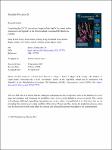Unraveling the CLCC1 interactome: Impact of the Asp25Glu variant and its interaction with SigmaR1 at the Mitochondrial-Associated ER Membrane (MAM).
| dc.contributor.author | D'Atri, I | |
| dc.contributor.author | Martin, E-R | |
| dc.contributor.author | Yang, L | |
| dc.contributor.author | Sears, E | |
| dc.contributor.author | Baple, E | |
| dc.contributor.author | Crosby, AH | |
| dc.contributor.author | Chilton, JK | |
| dc.contributor.author | Oguro-Ando, A | |
| dc.date.accessioned | 2024-04-25T13:27:22Z | |
| dc.date.available | 2024-04-25T13:27:22Z | |
| dc.date.issued | 2024-04-13 | |
| dc.identifier.issn | 0304-3940 | |
| dc.identifier.issn | 1872-7972 | |
| dc.identifier.uri | https://pearl.plymouth.ac.uk/handle/10026.1/22321 | |
| dc.description.abstract |
The endoplasmic reticulum (ER) plays an indispensable role in cellular processes, including maintenance of calcium homeostasis, and protein folding, synthesized and processing. Disruptions in these processes leading to ER stress and the accumulation of misfolded proteins can instigate the unfolded protein response (UPR), culminating in either restoration of balanced proteostasis or apoptosis. A key player in this intricate balance is CLCC1, an ER-resident chloride channel, whose essential role extends to retinal development, regulation of ER stress, and UPR. The importance of CLCC1 is further underscored by its interaction with proteins localized to mitochondria-associated endoplasmic reticulum membranes (MAMs), where it participates in UPR induction by MAM proteins. In previous research, we identified a p.(Asp25Glu) pathogenic CLCC1 variant associated with retinitis pigmentosa (RP) (CLCC1 hg38 NC_000001.11; NM_001048210.3, c.75C > A; UniprotKB Q96S66). In attempt to decipher the impact of this variant function, we leveraged liquid chromatography-mass spectrometry (LC-MS) to identify likely CLCC1-interacting proteins. We discovered that the CLCC1 interactome is substantially composed of proteins that localize to ER compartments and that the Asp25Glu variant results in noticeable loss and gain of specific protein interactors. Intriguingly, the analysis suggests that the CLCC1Asp25Glu mutant protein exhibits a propensity for increased interactions with cytoplasmic proteins compared to its wild-type counterpart. To corroborate our LC-MS data, we further scrutinized two novel CLCC1 interactors, Calnexin and SigmaR1, chaperone proteins that localize to the ER and MAMs. Through microscopy, we demonstrate that CLCC1 co-localizes with both proteins, thereby validating our initial findings. Moreover, our results reveal that CLCC1 co-localizes with SigmaR1 not merely at the ER, but also at MAMs. These findings reinforce the notion of CLCC1 interacting with MAM proteins at the ER-mitochondria interface, setting the stage for further exploration into how these interactions impact ER or mitochondria function and lead to retinal degenerative disease when impaired. | |
| dc.format.extent | 137778- | |
| dc.format.medium | Print-Electronic | |
| dc.language | eng | |
| dc.publisher | Elsevier | |
| dc.subject | CLCC1 | |
| dc.subject | Endoplasmic reticulum | |
| dc.subject | MAM | |
| dc.subject | Retinitis pigmentosa | |
| dc.subject | SigmaR1 | |
| dc.title | Unraveling the CLCC1 interactome: Impact of the Asp25Glu variant and its interaction with SigmaR1 at the Mitochondrial-Associated ER Membrane (MAM). | |
| dc.type | Journal Article | |
| plymouth.author-url | https://www.ncbi.nlm.nih.gov/pubmed/38621504 | |
| plymouth.publication-status | Published online | |
| plymouth.journal | Neurosci Lett | |
| dc.identifier.doi | 10.1016/j.neulet.2024.137778 | |
| plymouth.organisational-group | |Plymouth | |
| plymouth.organisational-group | |Plymouth|Faculty of Health | |
| plymouth.organisational-group | |Plymouth|REF 2021 Researchers by UoA | |
| plymouth.organisational-group | |Plymouth|Users by role | |
| plymouth.organisational-group | |Plymouth|Users by role|Current Academic staff | |
| plymouth.organisational-group | |Plymouth|REF 2021 Researchers by UoA|UoA01 Clinical Medicine | |
| plymouth.organisational-group | |Plymouth|Faculty of Health|Peninsula Medical School | |
| dc.publisher.place | Ireland | |
| dcterms.dateAccepted | 2024-04-12 | |
| dc.date.updated | 2024-04-25T13:27:20Z | |
| dc.rights.embargodate | 2024-04-27 | |
| dc.identifier.eissn | 1872-7972 | |
| rioxxterms.versionofrecord | 10.1016/j.neulet.2024.137778 |


